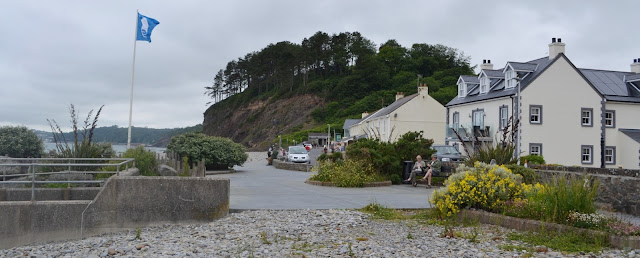|
We walked from the centre of Tenby along the streets bordering North Beach until private properties
prevented access to the beach and we had to walk some 300m inland from the
coast through fields and woods. The
woods are mostly sycamore, which seems to thrive in coastal air, with sessile
and pedunculate oaks and holly.
Woodland ground flora varied through the day (much of which was spent
passing through bands of trees) but was usually luxurious, such as massed
ferns – hart’s-tongue, hard fern, soft shield fern, sometimes lady fern and
scaly male fern, thick colonies of great wood-rush, or enchanter’s nightshade
with yellow pimpernel, wood-sorrel and primrose. At one point late in the day was a small
patch of cow-wheat. In another wood by
a stream a patch of common valerian.
Neither of these plants is often recorded on our coast walks.
The path was up
and down, sometimes steeply, along the coastal fringe from Tenby round
Monkstone Point and along to the centre of Saundersfoot. In the steep wood at Lodge Valley
we saw a brightly coloured bullfinch, not a bird we often see along the
coast. We entered Saundersfoot by back
streets above the harbour and then down the main road B4316 past St Brides
Spa, where we were staying. In the
small centre near the harbour at 11am we felt we had earned a coffee in a
little café, where we also purchased some lunch to take with us. As the tide was coming in and there were
few access places to the beach, we had to follow the coast path through the
streets of Saundersfoot to Coppet Hall Point, where we passed Coast
Restaurant and travelled on to Wiseman’s Bridge, a walk made easy by dark
tunnels bored through the headlands and a continuous promenade. We searched the beach for shells and soon
reached Amroth at 12.45, suitably for lunch.
There are a number of cafés and pubs which we might have used, but
having purchased food we sat on a bench overlooking a beach composed entirely
of a bank of large pebbles. We
continued along the promenade to Amroth ‘Castle’ (an ugly Victorian building,
now the base for a caravan park), shortly after which, passing a large amount
of reconstruction going on along the front, we reached New Inn. Nearby was the sign for the end of the
Pembrokeshire Coast Path, although we found that the boundary with
Carmarthenshire was actually about a kilometre further on.
We were now on
the more recent Welsh Coast Path, with its cryptic blue and yellow sign,
rather than Pembrokeshire’s white acorns.
Immediately the paths seemed less friendly and we had to pass through
thickets of gorse that scratched our arms on both sides. Some of the path signs had been defaced,
presumably by residents who object to the intrusion of walkers (usually
welcomed in Pembrokeshire). The long beach of Marros
Sands was completely inaccessible and privatised. Instead we had to use a track uncomfortably
strewn with loose stone chippings, with a thick wood on the seaward side
preventing any sight or feel of the sea and sand (although we could vaguely
hear the surf). This section also had
several tough ups and downs, especially at the end when we rose from Ragwen
Point and then descended to a small beach, followed immediately by another
stiff uphill path before we came down over hundreds of twisting steps to Pendine Beach.
Few creatures illuminated this section, but we had to step over the
usual death-defying bloody-nosed beetle – a species that has a particular
liking for paths; we saw a jay flying over and around the cliff scrub,
unusually for this woodland bird; and we saw a bright ginger-coloured moss
carder bee, a bumble bee of moors and coast, rare in the south. We arrived at Pendine at 4.15, in time for
the 4.30 bus that we waved down beside Beach Hotel after buying ice-cream and
postcards at the Post Office.
The cliffs today
were of acid soil and the vegetation unexceptional, except for trailing St
John's-wort. A few boggy areas
provided more records: cross-leaved heath, cuckooflower, marsh St
John’s-wort, bog pimpernel, and star sedge.
We ate again at
Coast – excellent food and wine, and very friendly, professional service.
|
Common
cow-wheat
Trailing
St John's-wort
|






No comments:
Post a Comment